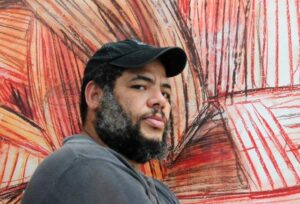Alexis Leyva Machado

Alexis Leyva Machado (Nueva Gerona, February 12, 1970), whose stage name is Kcho, is a Cuban sculptor, installationist, painter, printmaker, performance artist, curator, activist and politician. He is a deputy to the National Assembly of People’s Power. He began his studies in 1986 at the National School of Plastic Arts in the city of Havana, graduating in 1990.
His professional career began in 1990. Since then he has held more than 90 individual and 200 group exhibitions. In 1995, at age 25, Kcho became the youngest artist from Latin America to be part of the permanent collection of the Museum of Modern Art in New York (MoMA). Known for his large-scale installations, Kcho is also an excellent draftsman and creator of paintings, drawings and prints. He was the grand prize of the I Kwangju Biennale in South Korea in 1995, which launched him onto the international art scene. In Romerillo, a humble or socially complicated neighborhood of the Cubanacán popular council, located in the Playa municipality of the capital, Kcho has been developing a socially useful project for seven months, Kcho Estudio, with the aim of transforming the physical and mental spaces of its inhabitants. . A pretentious task that will only bear fruit through force of will and energy. But as he himself states “everything is possible by linking energies.”
It has an important collection of art, of the Cuban and international Avant-garde, of great heritage value and of utmost importance for the work of dissemination of the arts carried out by the Organic Museum in Havana and in other provinces of the country, since its proposal emanates from the universality of art and its opposite and coincident languages and proposals. The collection has a broad cultural panorama, coming from various countries and movements, which are shown throughout Cuba. The value of this collection and the global concept with which the Organic Museum enjoys, allows it to be easily inserted into any environment, beyond language and cultural barriers, as evidenced in works carried out in Haiti and Cuba; and in the interest shown by people, politicians, intellectuals and academics from all continents and countries who visit the place and show how from the Organic Museum it is possible to break down obstacles and positively transform people’s lives. Permanent and free workshops on plastic arts, film, engraving, and theater are taught, with wide participation of the public and students. They have the La Colmenita de Romerillo theater project, a theater for children, which involves the whole family. Its objective is to place art at the center of life, making it an essential element.
Awards
1990
•Award from the Hermanos Saíz Association, Municipal Hall of Plastic Arts, Isla de la Juventud.
1991
•Award from the National Hall of Artistic Teaching Professors, Provincial Center of Plastic Arts and Design, Havana.
1995
•UNESCO Prize for the Promotion of the Arts. Kwangji Biennale Grand Prix, South Korea.
1999
•Atelier Calder Residence, Saché, France.
2001
•Award for the Cuban submission to the IV Caribbean Biennial, Museum of Modern Art, Santo Domingo, Dominican Republic.
Personal Exhibitions
1986
•Fabelas. Plastic Arts Center, Isla de la Juventud, Cuba.
1991
•IV Havana Biennial. National Museum of Fine Arts, Havana.
1992
•Artist of the month. National Museum of Fine Arts, Havana.
1993
•Facility. Gallery of Contemporary Art, Mexico City, Mexico.
1994
•Looking for the similarity. Havana Gallery, Havana.
1995
•Kcho. Pilar and Joan Miró Foundation, Mallorca, Spain.
•The path of nostalgia. Wifredo Lam Center, Havana.
1996
•Barbara Gladstone Gallery, New York.Studio Guenzani, Milan, Italy.
•To forget. “Les Cent Jours d’Art Contemprain de Montreal”, Canada.
•Centre International d’Art contemporain de Montreal, Montreal, Canada.
•Kcho. Regen Projects, Los Angeles, United States.
1997
•Everything changes. Museum of Contemporary Art, Los Angeles, United States.
•Talking about the obvious was never a pleasure for us. the Israel Museum, Billy Rose Pavilion, Jerusalem.
1998
•Kcho. Galerie Nationale du Jeu de Paume, Paris, France.
•ARCO Fair 98. Madrid, Spain.
1999
•Calder Studio,Tours, France
2000
•Don’t thank me for the silence. House of the Americas, Havana.
•The Infinite Column. Reina Sofía National Art Center Museum, Madrid, Spain.
•Kcho. André Viana Gallery, Porto, Portugal.
•To forget. Convent of San Francisco de Asís, 7th Havana Biennial.
•Kcho Drawings. Bárbara Gladstone Gallery, New York, USA.
•Facilities. Tel Aviv, Israel.
2001
•To forget. Shiseido Gallery, Tokyo, Japan.
•Kcho, Drawings. Gallery 106, Austin, Texas, USA.
•There is nothing written in the sea. Havana Foundation Gallery, Havana.
•25 Stones. Exhibition of lithographs. Engraving Meeting 2001, Havana.
•Drawing is the Support of the Idea. Small Space Gallery, National Council of Plastic Arts, Havana.
•In the sea there is nothing written, drawings and lithographs. Martha Machado Gallery, Nueva Gerona, Isle of Youth.
•The jungle. National Museum of Fine Arts, Havana, Cuba
2002
•The jungle. Civic Gallery of Modern and Contemporary Art, Turin, Italy.